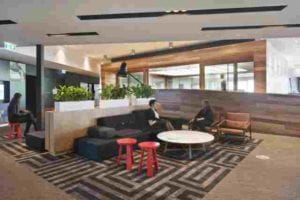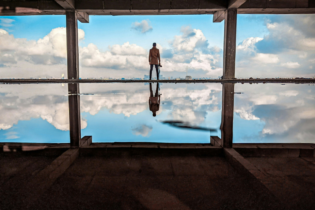Office buildings are becoming more futuristic in order to accommodate the needs of changing workforces, changing business practices, new technology, globalisation and client needs.
In this interview, Aurecon’s Pete Greaves, Technical Director: Buildings and Jeff Robinson, Development Leader: Property, discusses what futuristic office spaces will look like, what is driving these changes and how building services need to adapt in order to accommodate these needs.
What are the drivers of futuristic office spaces?
Pete: The need for more flexible working environments is clear. In the past, all employees worked from a specific office space but today employees work from home, from client sites, from cafes and from communal meeting rooms.
Work places need to be flexible in order to accommodate the needs of their workforce. The information and communication technologies (ICT) need to be adaptable in order to provide a seamless experience for everyone.
Someone working from home, for example, needs to be able to connect to a company’s servers and instant messaging systems in the same way that an office-bound worker is able to do.
What do futuristic workplaces look like?
Pete: Technology is everywhere. Futuristic workplaces incorporate technology that simplifies the building occupants’ lives in a sophisticated way. Forward-thinking office layouts also support activity-based working environments. For example, there are communal areas for brainstorming and meetings where people can work together.
Activity-based working environments boil down to matching individual employees and specific work tasks to environments and technologies that support those activities in order to enable greater efficiency and effectiveness.
How does this impact building services?
Pete: It is necessary to understand the capacity of the building’s services. Most offices are designed based on 1 person per 10 m
2. Activity-based work environments reduce this design load to 1 person per 7 m
2 or 8 m
2, therefore the building has to work harder to handle the increased load.
What changes do futuristic office spaces bring to the workplace environment?
Pete: The control of an employee’s local environment is increasingly being placed in their own hands. Task lighting, underfloor air distribution systems, blinds and motorised desks allow users to adjust their immediate surroundings to suit their needs.
How are sustainability, energy efficiency and green living incorporated into futuristic office spaces?
Pete: Futuristic office spaces aren’t all about technology and advanced ICT systems. Leading organisations are focusing on offering greater access to daylight, natural ventilation, better views and green spaces within and surrounding their buildings. Bringing the outdoors inside has become a greater priority in futuristic office spaces.
What is circadian lighting and is it being used in buildings?
Pete: Many office workers lack adequate exposure to daylight and get increased amounts of blue-rich light from their screens. Research has shown that the colour of light affects the functioning of the human body, so forward-thinking clients are installing artificial lighting with consideration of the effects on the circadian rhythm of workers in a commercial environment.
What other trends are there in futuristic office spaces?
Pete: Many organisations are focused on creating spaces where people can work, live and play. Some of the newer buildings, for example, have end-of-trip facilities for cyclists and runners.
Instead of cyclists parking their bikes in a basement or storeroom, they’ve got well-equipped facilities with towels, showers and wall-mounted bicycle racks. Other companies are installing basketball courts, gyms and volleyball courts in order to encourage people to be more active.
Click here to read Part 2: Jeff Robinson’s answers.








